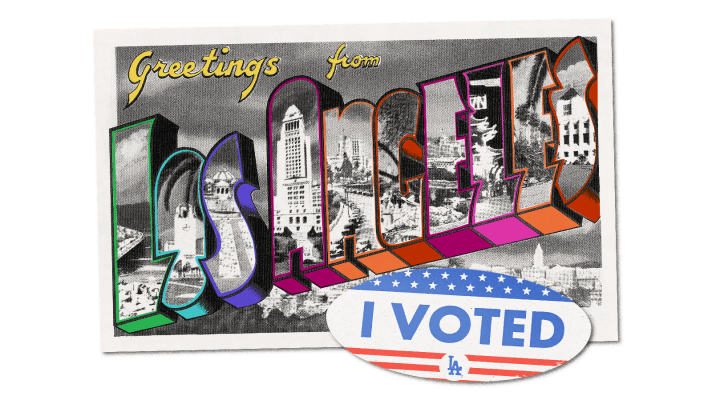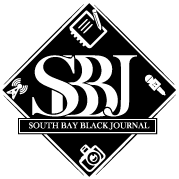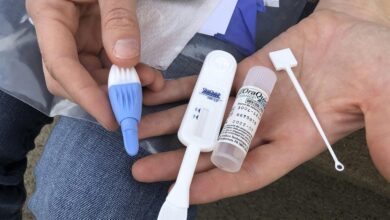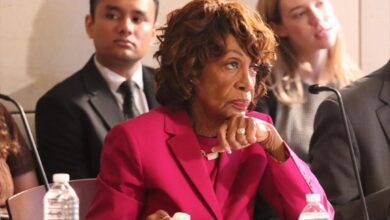The 6 Political Neighborhoods Of Los Angeles

PHOTO ILLUSTRATION BY EMILY SCHERER / GETTY IMAGES
Politics in Los Angeles are as complicated and knotty as its highway system. L.A. has so much inequality over so much space that its residents often want wildly different things from their politicians — even if nearly all of those politicians are Democrats.
The city’s open-seat mayoral election — whose first round takes place on Tuesday — reflects that paradox, with a pileup of Democrats pitching solutions to a city of 3.9 million residents.
Two of the 12 candidates on the ballot are clear front-runners: Rep. Karen Bass and billionaire real estate developer Rick Caruso have made public safety and cost of living central issues in their campaigns, but they have dramatically different visions of what a safer, more affordable L.A. should look like. Bass, who led the state Assembly before serving a decade in the U.S. House of Representatives, is the more progressive of the two. The former chair of the Black Congressional Caucus has leaned into her background as a community organizer in the city, highlighting her “crisis-tested” skill set that would help her address homelessness as a pressing economic and public health crisis. Caruso, meanwhile, is a former Republican who has blanketed the airwaves with dire depictions of the city’s uptick in crime, promising to “clean up” the streets and hire 1,500 more police officers. His big spending has helped him clear the field; in recent weeks, other candidates who sought to position themselves in the moderate lane have dropped out and endorsed him. L.A. Councilman Kevin de León — the only major Latino candidate in a city that is almost half Latino — is also running but has lagged behind Bass and Caruso in polls.
This election poses a problem for us incorrigible election-watchers: The major candidates are all Democrats, and Los Angeles is an almost uniformly Democratic city. So, to make sense of the city’s political fissures (and there certainly are plenty), we needed something more sophisticated. When we ran into the same problem sizing up the mayoral election in deep-blue New York City last year, we tried to show that its politics were far more complex than just “solidly Democratic” by dividing the city into five “political boroughs” based on the results of recent Democratic primaries. It’s only fair, then, that we give L.A. the same treatment on the occasion of its own big municipal election. (Let no one accuse FiveThirtyEight of East Coast bias!)
We’ve carved up Los Angeles into six political regions based on the results of seven elections on the November 2020 ballot: the presidential race, the district attorney’s race and five high-profile local ballot measures.
Together, these elections encapsulate several modern political cleavages:
- The contest between then-President Donald Trump and now-President Joe Biden gets at the traditional red-blue divide.
- The district attorney’s race shows support for a centrist Democrat (incumbent Jackie Lacey) versus a progressive criminal-justice reformer (George Gascón).
- Proposition 22, which sought to guarantee modest benefits to gig workers (e.g., Uber and Lyft drivers) in exchange for classifying them as independent contractors (and thus ineligible for fuller benefits), reveals Angelenos’ feelings on business and labor.
- Measure J, which sought to invest more money in communities of color to discourage incarceration, and Proposition 15, which would have effectively raised taxes on many commercial properties by taxing them at market value instead of purchase price, gauge how much residents want to redistribute wealth in their city.
- Measure J and Proposition 16, which aimed to overturn the state’s ban on affirmative action, get at attitudes on racial justice.
- Proposition 21, which tried to expand rent control, helps us see where city residents stand on the hot-button issue of housing.
With the mayoral race playing out along many of these same lines, we hope our six “political neighborhoods” will be useful for interpreting the results as they come in on Tuesday night (and, because California votes by mail, in the days after). But even if you don’t care about who leads Los Angeles, these regions also highlight broader truths common to many American cities: People of color are strong Democrats but aren’t necessarily strong liberals; trendy white neighborhoods have some of the most progressive politics in the city; Latinos can’t be pegged to a single political identity; and even in dark-blue cities, you can still find support for conservative candidates and causes.
South Central

Our tour of L.A.’s political geography begins with the political neighborhood of South Central, which almost entirely overlaps with the real-life neighborhood of the same name situated between Downtown L.A. and the 105. This is the most deeply Democratic region of a deeply Democratic city: Biden carried South Central with 87 percent of the vote. And it is also very liberal on racial-justice issues. For instance, Measure J passed here with a well-above-average 71 percent of the vote, while affirmative action was very popular here as well.
South Central demographics
| Demographic | Percentage |
|---|---|
| Hispanic | 68% |
| White | 5 |
| Asian American | 3 |
| Black | 22 |
South Central 2020 election results
| Race | Candidate | Vote Share |
|---|---|---|
| President | Biden | 87% |
| Trump | 11 | |
| DA runoff | Gascón | 57 |
| Lacey | 43 | |
| Ballot measure | Yes | No |
| Measure J | 71% | 29% |
| Proposition 15 | 65 | 35 |
| Proposition 16 | 67 | 33 |
| Proposition 21 | 59 | 41 |
| Proposition 22 | 55 | 45 |
None of these results is surprising when you consider that South Central residents are almost all people of color: 68 percent of the voting-age population here is Hispanic, while 22 percent are Black; by contrast, only 5 percent of the voting-age population in this political neighborhood is white.
Although Black residents are not the majority in this region, predominantly Black areas do set the tone for some of its politics: Biden’s, Measure J’s and Proposition 16’s best showings in South Central came in majority-Black ballot groups like those in Hyde Park. Yet the neighborhood’s strong support for Proposition 15 was driven mostly by heavily Hispanic areas. While support for raising taxes on commercial properties reached as high as 70 percent in Hispanic ballot groups, it was closer to 60 percent in Black ones.
South Central may be strongly Democratic and liberal on certain issues, but it’s not necessarily a progressive stronghold. With high crime rates being a perennial problem in this neighborhood, a significant number of voters here supported Lacey and her more punitive approach to preventing crime. (She also grew up in the neighborhood.) South Central supported Gascón for district attorney with only 57 percent of the vote, below his citywide haul of 59 percent. And despite Proposition 22’s cap on gig workers’ benefits, residents of this working-class neighborhood may have been convinced by Uber and Lyft’s argument that jobs would be cut if the measure failed. Proposition 22 passed here 55 percent to 45 percent, making South Central its second-best neighborhood.
It will be interesting to see who wins out here in the mayor’s race. As a Black Democrat who represents part of the neighborhood in Congress, Bass seems a good fit on paper. But Caruso’s more populist tendencies — such as talking tough on crime — could appeal to South Central too.
True-Blue Progressives

Los Angeles’s True-Blue Progressives — our second political neighborhood — can be found mostly (but not exclusively) north of Downtown. That’s where you’ll find the hip neighborhoods of Silver Lake, Echo Park and Los Feliz, as well as Northeast Los Angeles, a predominantly Hispanic neighborhood with a suburban feel. But the True-Blue Progressives neighborhood also encompasses the chic corridors of Hollywood and Wilshire Boulevards and, several miles to the southwest, the traditional hippie haunt of Venice.
True-Blue Progressives demographics
| Demographic | Percentage |
|---|---|
| Hispanic | 38% |
| White | 37 |
| Asian American | 16 |
| Black | 4 |
True-Blue Progressives 2020 election results
| Race | Candidate | Vote Share |
|---|---|---|
| President | Biden | 83% |
| Trump | 15 | |
| DA runoff | Gascón | 69 |
| Lacey | 31 | |
| Ballot measure | Yes | No |
| Measure J | 74% | 26% |
| Proposition 15 | 69 | 31 |
| Proposition 16 | 67 | 33 |
| Proposition 21 | 67 | 33 |
| Proposition 22 | 41 | 59 |
This is indisputably L.A.’s most progressive region. It was the strongest of our six neighborhoods for Gascón as well as for all the further-left positions on the local ballot measures. Most notably, it was the only neighborhood to break strongly with Big Tech on Proposition 22, voting against it 59 percent to 41 percent.
Taken as a whole, the True-Blue Progressives neighborhood is racially and ethnically mixed; Latinos are the biggest demographic group, but they make up only 38 percent of the area’s voting-age population. However, the white voting-age population is larger than the citywide average. Interestingly, there aren’t significant differences in how the plurality-Hispanic and plurality-white parts of this neighborhood vote; both are dyed-in-the-wool progressive.
In the mayoral race, it would be a big surprise if Bass didn’t crush Caruso here. But de León could post good numbers here too, considering that he represents parts of Northeast L.A. on the city council. He hasn’t fully embraced progressivism in his mayoral campaign, but he did run for U.S. Senate in 2018 as a more liberal alternative to Sen. Dianne Feinstein. Finally, if Gina Viola — the race’s only full-bore progressive candidate — were going to make a splash anywhere, it should be here. Unfortunately for her, though, she is polling at around 2 percent citywide.
Fair-Weather Progressives

The Fair-Weather Progressives neighborhood follows the path of the 10 across central Los Angeles, from predominantly white Culver City through heavily Black Crenshaw, significantly Asian American Koreatown, diverse Downtown and heavily Hispanic Eastside L.A.
Fair-Weather Progressives demographics
| Demographic | Percentage |
|---|---|
| Hispanic | 44% |
| White | 21 |
| Asian American | 17 |
| Black | 14 |
Fair-Weather Progressives 2020 election results
| Race | Candidate | Vote Share |
|---|---|---|
| President | Biden | 83% |
| Trump | 15 | |
| DA runoff | Gascón | 64 |
| Lacey | 36 | |
| Ballot measure | Yes | No |
| Measure J | 73% | 27% |
| Proposition 15 | 67 | 33 |
| Proposition 16 | 66 | 34 |
| Proposition 21 | 64 | 36 |
| Proposition 22 | 48 | 52 |
With a demographic composition that’s similar to the city’s as a whole, the population of this area is diverse, and most of its voting population is liberal. It was Biden’s, Gascón’s, Measure J’s, Proposition 15’s and Proposition 21’s second-best political neighborhood. But where it differs from the True-Blue Progressives is its vote on Proposition 22: Fair-Weather Progressives voted to give gig workers the benefits of full employment by a tighter margin of 52 percent to 48 percent. On the spectrum of progressivism, then, this neighborhood falls somewhere between True-Blue Progressives and South Central.
Predominantly white ballot groups like those covering Sawtelle and ballot groups with significant Asian American populations like those in Koreatown were less supportive of Biden than the neighborhood’s Hispanic sectors. Those white ballot groups were also more skeptical of affirmative action and expanded rent control.
Expect the Fair-Weather Progressives to support Bass for mayor; her orientation as more-progressive-than-Caruso-but-not-capital-P-progressive seems to be a perfect fit for voters here. But de León will be counting on a strong showing here too, especially in Downtown and Eastside L.A., which are also largely in his city council district.
Tinseltown

When you think of the glitz and glamour of Los Angeles, you’re probably thinking about the next political neighborhood: Tinseltown. This neighborhood includes ballot groups in Hollywood Hills, Studio City and Beverly Crest as well as West Los Angeles and Century City. While two Angelenos will probably give you three different definitions of this area, it includes a solid piece of Hollywood. Tinseltown is largely white, trends wealthier than neighborhoods to its east and south and votes fairly liberal.
Tinseltown demographics
| Demographic | Percentage |
|---|---|
| Hispanic | 13% |
| White | 63 |
| Asian American | 14 |
| Black | 4 |
Tinseltown 2020 election results
| Race | Candidate | Vote Share |
|---|---|---|
| President | Biden | 77% |
| Trump | 21 | |
| DA runoff | Gascón | 62 |
| Lacey | 38 | |
| Ballot measure | Yes | No |
| Measure J | 67% | 33% |
| Proposition 15 | 60 | 40 |
| Proposition 16 | 57 | 43 |
| Proposition 21 | 57 | 43 |
| Proposition 22 | 48 | 52 |
This neighborhood neither swung as hard for Biden as the more left-leaning neighborhoods nor swung as hard for Lacey as the more conservative neighborhoods. Gascón overperformed his citywide averages in Tinseltown by 3 percentage points, while Biden ran about average. And when it comes to the propositions, Tinseltown was fairly middle-of-the-pack. While Proposition 16 passed here with a slightly smaller margin compared with the citywide average, Propositions 15 and 21 basically matched the L.A. averages. The most significant differentiator was Proposition 22, which failed by the narrowest of margins (fewer than 5,000 votes out of almost 131,000 cast).
Though its 2020 voting pattern is pretty similar to the city’s overall, Tinseltown doesn’t particularly resemble L.A as a whole. Among all the political neighborhoods, this one has by far the largest share of the white voting-age population, at 63 percent, and it’s the only political neighborhood where every ballot group is at least a plurality white. It also has the smallest share of the Hispanic voting-age population, at just 13 percent. Six of the seven ballot groups where Proposition 16 garnered less support than the city average had a higher share of voting-age white residents than the neighborhood and the city overall.
Hollywood stars and industry leaders have split on Caruso and Bass, with each candidate collecting endorsements from a number of big names, and given the liberal but not too liberal voters of Tinseltown, it seems as though this neighborhood could go either way.
Inner Suburbs

The Inner Suburbs is a transitional neighborhood that covers much of the San Fernando Valley and some of the westernmost neighborhoods of L.A., which include Pacific Palisades and Brentwood.
Inner Suburbs demographics
| Demographic | Percentage |
|---|---|
| Hispanic | 55% |
| White | 29 |
| Asian American | 9 |
| Black | 4 |
Inner Suburbs 2020 election results
| Race | Candidate | Vote Share |
|---|---|---|
| President | Biden | 74% |
| Trump | 24 | |
| DA runoff | Gascón | 56 |
| Lacey | 44 | |
| Ballot measure | Yes | No |
| Measure J | 60% | 40% |
| Proposition 15 | 56 | 44 |
| Proposition 16 | 54 | 46 |
| Proposition 21 | 54 | 46 |
| Proposition 22 | 54 | 46 |
This fairly expansive political neighborhood lies closer to the city’s denser urban center compared with the Outer Suburbs (our final political neighborhood, and the most conservative). Propositions 15, 16 and 21 all passed here, unlike in the Outer Suburbs, but by the smallest margins among the city’s political neighborhoods. With the Asian and Black voting-age populations together totaling less than 15 percent, it’s predominantly white and Hispanic. Five ballot groups are majority Hispanic, five are majority white and the remaining five are more diverse.
The Inner Suburbs’ support for more local rent control was driven primarily by five majority-Hispanic ballot groups. The five majority-white ballot groups, meanwhile, brought down the region’s support for raising nonresidential property taxes, voting 52 percent in favor versus the rest of the neighborhood’s 56 percent.
Caruso owns a home in this neighborhood, as do a handful of his celebrity endorsers, such as record executive and Taylor Swift archrival Scooter Braun. Still, the liberal-leaning tendencies of this group, particularly on issues related to housing and funding, indicate that Bass could find a foothold.
Outer Suburbs

We’ll end on the closest thing Los Angeles has to a conservative political neighborhood, which comprises two distinct areas: a northern region that covers the western and eastern edges of the San Fernando Valley, plus the southern neighborhoods of San Pedro, Wilmington and Harbor City near the Port of Los Angeles. Biden garnered 64 percent of the vote here, by far his worst showing, while Lacey got 51 percent — the only political neighborhood in which she beat Gascón. This neighborhood was also the only one where Propositions 15, 16 and 21 all failed, as none surpassed 47 percent of the vote.
Outer Suburbs demographics
| Demographic | Percentage |
|---|---|
| Hispanic | 31% |
| White | 45 |
| Asian American | 14 |
| Black | 5 |
Outer Suburbs 2020 election results
| Race | Candidate | Vote Share |
|---|---|---|
| President | Biden | 64% |
| Trump | 34 | |
| DA runoff | Gascón | 49 |
| Lacey | 51 | |
| Ballot measure | Yes | No |
| Measure J | 51% | 49% |
| Proposition 15 | 46 | 54 |
| Proposition 16 | 44 | 56 |
| Proposition 21 | 44 | 56 |
| Proposition 22 | 59 | 41 |
That this neighborhood is the most hesitant to commit to wealth redistribution and racial equity isn’t surprising when you consider its proximity to two of the historically conservative regions in the state: Orange County and northern L.A. County. The Outer Suburbs supported the reclassification of gig workers as contractors with a city-high 59 percent of the vote. Increasing funding for anti-incarceration programs squeaked by on the narrowest of margins, attracting 51 percent of the vote — 14 points lower than the city average.
The averages disguise some geographic divides. The San Fernando Valley itself is politically and demographically diverse, but as it nears the San Joaquin Valley to the north, wealthier communities like Woodland Hills and Chatsworth begin to tack right. And down south, the historically industrial Harbor communities and the “Shoestring Strip” are a little less conservative than their northern counterparts: Three of the four ballot groups voted in support of Measure J, compared with just four of the 12 comprising the political neighborhood’s northern reaches, and two voted in favor of Proposition 15.
While Bass has made efforts to reach out to this political neighborhood, it’s reasonable to think that, given its support for Lacey two years ago, Caruso’s tough-on-crime messaging will resonate here.
The partisan affiliation of the next mayor of L.A. seems clear, but the nature of his or her coalition is not. Los Angeles faces the same internal tensions as many other American cities: longstanding racial inequities, a population sensitive to rising crime and a housing crisis crushing residents, particularly those with lower incomes. Resolving those tensions will be more difficult than the city’s deep-blue hue might indicate. With relatively little agreement on what L.A. ought to do about these challenges, the next mayor will have to convince skeptical neighborhoods that his or her vision is the right one.
Additional research by Aaron Bycoffe. Copy editing by Andrew Mangan. Story editing by Chadwick Matlin.
CORRECTION (June 7, 2022, 2:57 p.m.): A previous version of this article suggested that the Outer Suburbs political neighborhood borders Orange County. In fact, part of Los Angeles County separates the Outer Suburbs from Orange County, so the Outer Suburbs are just close to Orange County.




